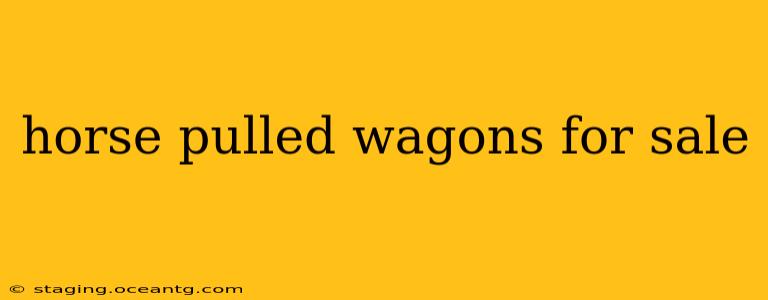Finding the perfect horse-pulled wagon can be an exciting journey, whether you're envisioning picturesque countryside drives, participating in parades, or simply adding a touch of rustic charm to your property. This comprehensive guide will walk you through the process, helping you navigate the market and find the ideal wagon to suit your needs and budget.
What Types of Horse-Pulled Wagons Are Available?
The world of horse-drawn wagons is surprisingly diverse! Understanding the different types is crucial for making an informed purchase. Here are some of the most common varieties:
-
Farm Wagons: These sturdy workhorses are designed for hauling heavy loads, featuring robust construction and large carrying capacities. They're typically boxy and utilitarian, prioritizing function over aesthetics.
-
Conestoga Wagons: Iconic covered wagons, known for their distinctive curved bed and canvas cover, Conestogas are a popular choice for historical reenactments and decorative purposes. They represent a piece of American history and are often meticulously restored.
-
Buggies: Smaller and lighter than farm wagons, buggies are better suited for passenger transport. They offer a more elegant and comfortable ride, often featuring suspension systems and plush seating. Variations include surreys, phaetons, and more.
-
Carts: Smaller than wagons, carts often lack a body and are typically used for hauling lighter loads or specific tasks, like transporting tools or produce.
-
Sleighs: While technically not wagons, sleighs are often included in the horse-drawn vehicle category, particularly for winter use. They're designed for snow and ice and offer a unique and festive experience.
What Should I Look for When Buying a Horse-Pulled Wagon?
Choosing the right horse-pulled wagon requires careful consideration of several factors:
-
Condition: Thoroughly inspect the wagon's structure, wheels, axles, and other components. Look for signs of wear and tear, rot, or damage. Rust is a common issue, especially on older wagons.
-
Size and Capacity: Consider the size of your horses and the weight of the loads you plan to carry. A wagon that's too small will be overloaded, while one that's too large may be difficult to manage.
-
Materials: Wagons are constructed from various materials, including wood, steel, and even fiberglass. Wood wagons offer a classic look but require more maintenance. Steel and fiberglass offer greater durability but may lack the charm of wood.
-
Brakes and Safety Features: Ensure the wagon has functional brakes and any necessary safety features to prevent accidents. This is crucial for both the horses and the passengers.
-
Price: Prices vary widely depending on the wagon's age, condition, type, and features. Research the market to get a sense of fair pricing before making an offer.
Where Can I Find Horse-Pulled Wagons for Sale?
You can explore several avenues when searching for horse-pulled wagons:
-
Online Marketplaces: Sites like eBay, Craigslist, and specialized equestrian websites often list horse-drawn vehicles for sale.
-
Auction Houses: Livestock and farm auctions are excellent places to find horse-pulled wagons, sometimes at bargain prices.
-
Antique Shops and Dealers: Antique shops and specialized dealers may have restored or antique wagons for sale.
-
Private Sellers: Network within the equestrian community; private sellers may be willing to part with their wagons.
How Much Does a Horse-Pulled Wagon Cost?
The cost of a horse-pulled wagon can range significantly, from a few hundred dollars for a basic, used cart to tens of thousands of dollars for a meticulously restored Conestoga wagon. The price depends on factors like the wagon's type, age, condition, and any restoration work required.
What are the Maintenance Needs of a Horse-Pulled Wagon?
Maintaining a horse-pulled wagon involves regular inspections, cleaning, lubrication, and repairs. Wood wagons require periodic painting or staining to prevent rot and weathering. Metal components may require rust prevention and occasional repairs.
This guide provides a solid foundation for your search. Remember to always prioritize safety and conduct thorough research before committing to a purchase. Happy wagon hunting!
